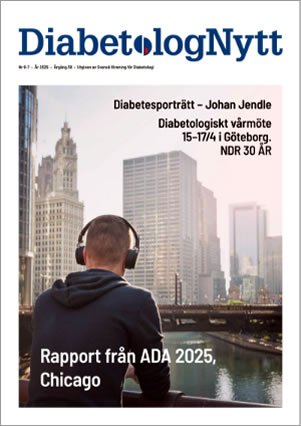Diabetes
Högre överdödlighet hos unga med typ 2-diabetes
Personer med typ 2-diabetes som är yngre än 55 år har högre dödlighet jämfört med friska i samma ålder, enligt en svensk studie med fler än 400 000 diabetespatienter. Dessa personer kanske måste behandlas mer intensivt, enligt professor Annika Rosengren, i en intervju på www.dagensmedicin.se signerad Amina Manzoor.
Överdödligheten hos personer med typ 2-diabetes är generellt sett låg enligt en ny svensk studie publicerad i tidskriften New England Journal of Medicine. Men överdödligheten varierar stort mellan olika grupper.
– Det finns både grupper som har en hög överrisk och grupper som har en väldigt liten överrisk. Till exempel har de som är 75 år eller äldre en väldigt liten överrisk att dö i hjärt-kärlsjukdom jämfört med dem utan diabetes. Eftersom de flesta som har typ 2-diabetes är äldre är den generella överrisken låg, och lägre än man tidigare trott. Men tittar man på undergrupper, till exempel hos de som är under 55 år, så finns en kraftig ökning av risken, säger Annika Rosengren, professor i medicin vid Sahlgrenska akademin vid Göteborgs universitet och medförfattare till studien.
Personer med typ 2-diabetes som var yngre än 55 år hade en två till tre gånger högre överdödlighet jämfört med friska personer i samma åldersgrupp. En ökad risk fanns även hos personer med välkontrollerade blodsockernivåer.
Men Annika Rosengren påpekar att dödligheten ändå är låg i absoluta tal för personer under 55 år.
– Det handlar om sex till sju dödsfall per tusen personår hos personer med diabetes, jämfört med tre per tusen personår hos friska. Och för kardiovaskulär död är det två per tusen personår, jämfört med 0,7 hos friska, säger hon.
Annika Rosengren menar att överdödligheten pekar på att den åldersgruppen kanske inte behandlas tillräckligt intensivt.
– Framförallt när det gäller kardiovaskulär död är det förebyggbart och behandlingsbart, där kanske vi inte har nått tillräckligt långt. Vi vet från andra studier att vi inte är tillräckligt bra på att använda de välbeprövade läkemedel som finns för att behandla höga blodfetter och högt blodtryck.
Andra riskfaktorer för överdödlighet vid typ 2-diabetes var svårkontrollerat blodsocker och njursjukdom.
– Vi vet från tidigare studier att prognosen försämras när man börjar få tecken på njursjukdom. Där måste vi intensifiera kontrollerna av de andra riskfaktorerna som blodsocker, blodtryck och blodfett, säger Annika Rosengren.
 Forskarna inkluderade 435 369 personer med typ 2-diabetes utifrån Nationella diabetesregistret. De jämfördes med en kontrollgrupp på 2 117 483 personer från befolkningen. Under uppföljningstiden avled 17,7 procent av patienterna i diabetesgruppen, som i snitt var 66 år gamla, jämfört med 14,5 procent av de jämnåriga patienterna i kontrollgruppen. Den vanligaste dödsorsaken var hjärt-kärlsjukdom.
Forskarna inkluderade 435 369 personer med typ 2-diabetes utifrån Nationella diabetesregistret. De jämfördes med en kontrollgrupp på 2 117 483 personer från befolkningen. Under uppföljningstiden avled 17,7 procent av patienterna i diabetesgruppen, som i snitt var 66 år gamla, jämfört med 14,5 procent av de jämnåriga patienterna i kontrollgruppen. Den vanligaste dödsorsaken var hjärt-kärlsjukdom.
Despite Advances, Type 2 Diabetics Still Face Elevated Death Risk: Study
That’s why it’s imperative to eat right, control blood pressure and cholesterol, quit smoking, as well as a better HbA1c, and also prevention against diabetic kidney failure, doctors say

WEDNESDAY, Oct. 28, 2015 (HealthDay News) — Medical science has made tremendous progress in prolonging the lives of people with type 2 diabetes. But, the prognosis still remains poor for patients who don’t keep their blood sugar levels under control, according to results from a large-scale Swedish study.
People with type 2 diabetes carry a 15 percent increased risk of premature death compared to healthy people, the researchers reported in the Oct. 29 issue of the New England Journal of Medicine.
Those odds aren’t great, but they’re much better than they were as recently as 15 years ago, said senior author Dr. Marcus Lind, a physician at the University of Gothenburg in Sweden.
”Up to the year 2000, the excess risk of mortality in individuals with type 2 diabetes was generally considered to be doubled compared to the general population, implying a doubled risk to die during the following years,” Lind said.
Now, the overall death rate for diabetics has ”dropped to historical low levels,” he added.
However, the risk of death is much higher in people younger than 65, those who poorly control their blood sugar levels, and those who’ve suffered kidney damage from type 2 diabetes, the researchers found.
The upshot is this — type 2 diabetics have to do their part in managing their condition if they want the benefits that medical advances have wrought, said Dr. Robert Ratner, chief scientific and medical officer for the American Diabetes Association.
”If you develop diabetes, there is good evidence that attention to glucose [blood sugar] control and other cardiovascular risk factors from the onset can reduce any individual’s risk of death,” Ratner said.
The new study used data from the Swedish National Diabetes Register to compare the death rate among just over 435,000 people with type 2 diabetes with that of a healthy control group of 2.1 million people.
Type 2 diabetics younger than 65 have a death risk substantially greater than that of older diabetics, according to the study findings.
Excess risk of death was two to three times higher among those younger than 55, compared to between 30 percent and 40 percent higher for diabetics aged 65 to 75.
”What you begin to see is the increased risk of mortality in diabetes is highest the younger you are,” Ratner said. ”The significant impact is really in those individuals under the age of 75, and it gets progressively greater as you go younger.”
The study authors speculated that the higher death rates seen among younger diabetics might owe, in part, to some gap in the care offered to these people.
Poor control of blood sugar levels can make that bad situation even worse for younger diabetics, the researchers found.
Anyone who didn’t manage their diabetes through lifestyle changes, insulin or medication faced a greatly increased risk of death, said study co-author Dr. Mikhail Kosiborod. He is a cardiologist at Saint Luke’s Mid America Heart Institute and a professor of medicine at the University of Missouri-Kansas City.
”If you look at the data, regardless of the age we look at, regardless of everything else, the worse the glycemic control the higher the mortality,” Kosiborod said.
But diabetics under 55 with poorly controlled blood sugar had a more than fourfold increased risk of early death, compared to healthy people. That risk was 55 percent higher for diabetics 75 and older who didn’t bother to manage their diabetes, the findings showed.
Finally, a patient’s death risk skyrockets if poorly controlled diabetes results in damage to their kidneys, the researchers said.
Diabetics younger than 55 who’ve entered end-stage kidney disease are 14 times more likely to die than a healthy person, according to the study.
End-stage kidney disease also multiplies the death risk sevenfold for diabetics 55 to 64, and sixfold for diabetics 65 to 74, the investigators found.
”Renal [kidney] disease and worsened kidney function are huge risk factors for overall mortality, regardless of age group,” Kosiborod said.
Kosiborod concluded that ”the strong message from our data is that if you are a young patient, there’s a lot you can do to protect your health.”
These steps include eating right, quitting smoking, and controlling blood pressure and cholesterol levels, he said.
But the best thing a person can do is try to avoid getting type 2 diabetes in the first place, Kosiborod added.
Type 2 diabetes prevention is possible, he said. ”Clinical trials have shown that aggressive and intensive lifestyle interventions can prevent diabetes. You should do everything you possibly can to prevent this condition from occurring,” Kosiborod said.
SOURCES: Marcus Lind, M.D., Ph.D., physician, University of Gothenburg, Sweden; Robert Ratner, M.D., chief scientific and medical officer, American Diabetes Association; Mikhail Kosiborod, M.D., cardiologist at Saint Luke’s Mid America Heart Institute, and a professor of medicine, the University of Missouri-Kansas City; Oct. 29, 2015, New England Journal of Medicine
From http://consumer.healthday.com
N Engl J Med 2015;373:1720-1732
Excess Mortality among Persons with Type 2
Diabetes
Mauro Tancredi, M.D., Annika Rosengren, M.D., Ann‑Marie Svensson, Ph.D.,
Mikhail Kosiborod, M.D., Aldina Pivodic, M.Sc., Soffia Gudbj.rnsdottir, M.D., Ph.D.,
Hans Wedel, Ph.D., Mark Clements, M.D., Ph.D., Sofia Dahlqvist,
and Marcus Lind, M.D., Ph.D.
ABSTRACT
BACKGROUND
The excess risks of death from any cause and death from cardiovascular causes
among persons with type 2 diabetes and various levels of glycemic control and
renal complications are unknown. In this registry-based study, we assessed these
risks according to glycemic control and renal complications among persons with
type 2 diabetes.
METHODS
We included patients with type 2 diabetes who were registered in the Swedish
National Diabetes Register on or after January 1, 1998. For each patient, five controls
were randomly selected from the general population and matched according
to age, sex, and county. All the participants were followed until December 31, 2011,
in the Swedish Registry for Cause-Specific Mortality.
RESULTS
The mean follow-up was 4.6 years in the diabetes group and 4.8 years in the control
group. Overall, 77,117 of 435,369 patients with diabetes (17.7%) died, as compared
with 306,097 of 2,117,483 controls (14.5%) (adjusted hazard ratio, 1.15; 95% confidence
interval [CI], 1.14 to 1.16). The rate of cardiovascular death was 7.9%
among patients versus 6.1% among controls (adjusted hazard ratio, 1.14; 95% CI,
1.13 to 1.15). The excess risks of death from any cause and cardiovascular death
increased with younger age, worse glycemic control, and greater severity of renal
complications. As compared with controls, the hazard ratio for death from any
cause among patients younger than 55 years of age who had a glycated hemoglobin
level of 6.9% or less (≤52 mmol per mole of nonglycated hemoglobin) was 1.92
(95% CI, 1.75 to 2.11); the corresponding hazard ratio among patients 75 years of
age or older was 0.95 (95% CI, 0.94 to 0.96). Among patients with normoalbuminuria,
the hazard ratio for death among those younger than 55 years of age with a
glycated hemoglobin level of 6.9% or less, as compared with controls, was 1.60
(95% CI, 1.40 to 1.82); the corresponding hazard ratio among patients 75 years of
age or older was 0.76 (95% CI, 0.75 to 0.78), and patients 65 to 74 years of age also
had a significantly lower risk of death (hazard ratio, 0.87; 95% CI, 0.84 to 0.91).
CONCLUSIONS
Mortality among persons with type 2 diabetes, as compared with that in the general
population, varied greatly, from substantial excess risks in large patient groups
to lower risks of death depending on age, glycemic control, and renal complications.
(Funded by the Swedish government and others.)
Nyhetsinfo
www red DiabetologNytt

